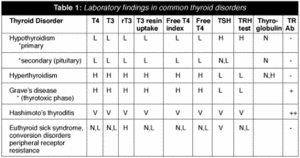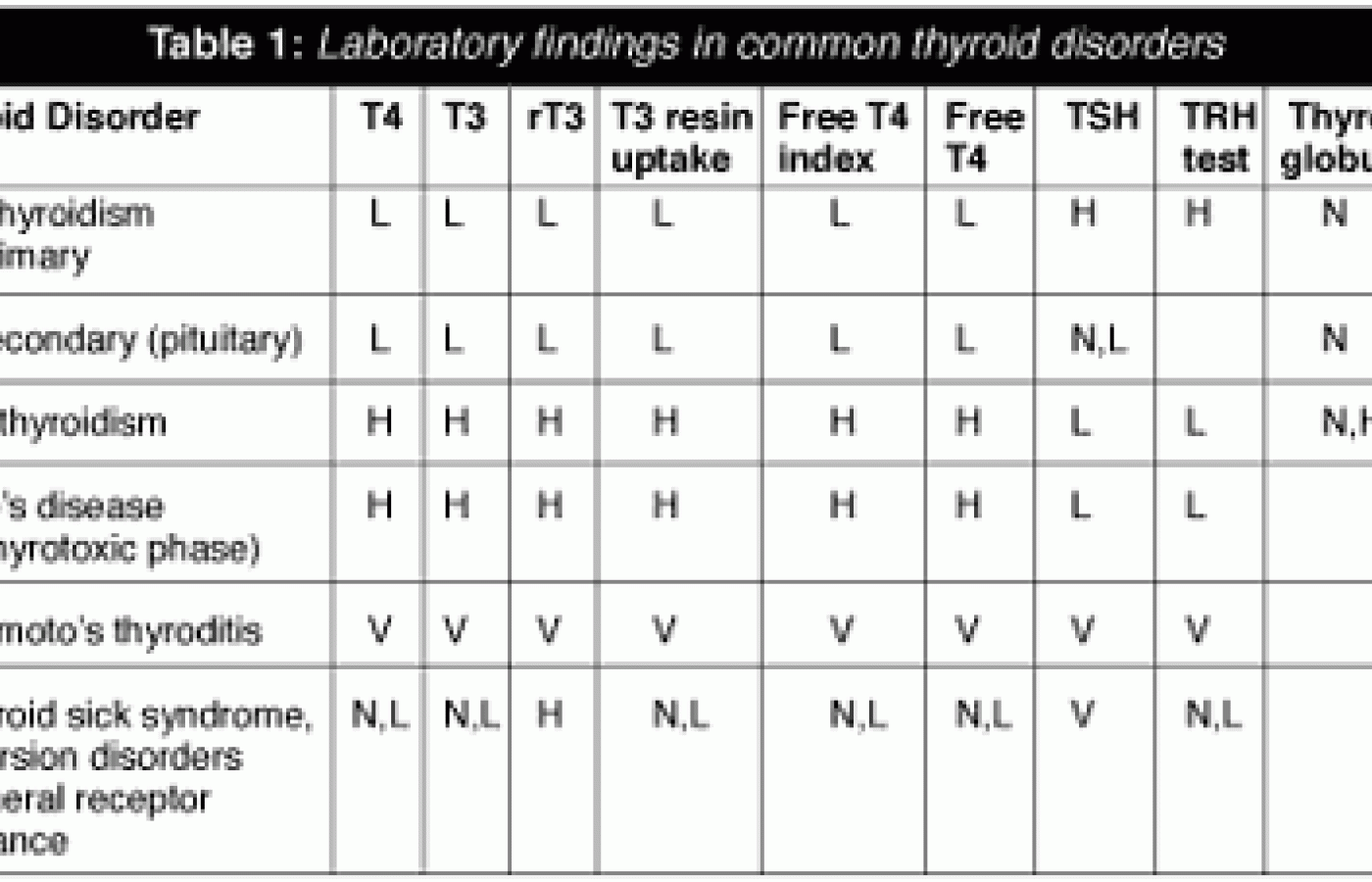On Oct. 21, 2025, a judge in Florida issued a groundbreaking decision in Complete Care v State Farm, 25-CA-1063. It concerns a fact pattern that many chiropractic doctors have faced wherein an insurer, such as State Farm or Allstate, decides to simply stop paying all claims submitted by a healthcare provider.
| Digital ExclusiveFunctional Thyroid Disorders, Part II
In the March 20 issue, I explored hypothyroidism in detail. In this second and final part, I'll discuss hyperthyroidism and thyroid cancer.
Hyperthyroidism (thyrotoxicosis): Like hypothyroidism, there are many subtypes of hyperthyroidism. The most common form is Grave's disease. Grave's disease is an autoimmune disorder of the thyroid, resulting in thyroid enlargement, hyperactivity, and detectable serum antibodies to fractions of the thyroid gland. The disease is more prevalent in females (8:1), with an average age of onset of between 20 and 40 years of age. Other causes of hyperthyroidism include: subacute thyroditis (possibly due to viral infection); autonomous toxic thyroid adenomas (hyperfunctioning thyroid nodules); Jod-Basedow disease (iodine-induced and commonly seen as a result of multiple radiographic contrast studies or drugs); pituitary (TSH hypersecretion by the pituitary); thyrotoxicosis factitia (secondary to over-medication with thyroid hormone replacement medication or consumption of ground beef contaminated with bovine thyroid tissue); and Hashimoto's thyroiditis (an auto-immunity disorder affecting the thyroid).2,4 Hashimoto's thyroiditis can cause hyperthyroidism during the initial acute phase of the disease, but tends to eventually result in a hypothyroid condition, due to destruction of the hormone producing thyroid tissue.
General signs and symptoms of hyperthyroidism include: cold intolerance; sweating; weight changes (usually weight loss); irritability; fatigue; weakness; nervousness; and menstrual irregularity.2-4 Musculoskeletal signs and symptoms associated with hyperthyroidism are not as overt as in hypothyroidism. They include: proximal limb weakness (usually in the upper extremity); muscle atrophy and fasciculations; brisk deep tendon reflexes; and possible Babinski's sign. Bulbar and respiratory muscle weakness, dysphagia, hoarseness, weakness of chewing, weakness of the tongue, and retraction of the upper eye lid (lid lag) may also be apparent.2-4,7,10
Just as in hypothyroidism, it is incumbent upon the chiropractor to be cognizant of these signs and symptoms; to include hyperthyroidism in the differential diagnosis when findings such as those listed are observed; and to assure that the patient is directed to proper treatment to avoid the serious complications (including cardiac abnormalities) of hyperthyroidism.
The most useful laboratory tests to evaluate for hyperthyroidism are total T4, the free thyroxine index (FTI), and total T3. Serum T3, T4, free thyroxine index and thyroid resin uptake are usually all elevated with a depressed TSH. Serum thyroperoxidase and thyroglobulin antibody titers, as well as ANA (antinuclear antibodies), are high only in cases of auto-immune processes causing hyperthyroidism, such as in Grave's disease and early Hashimoto's thyroiditis (see Table 1). Other common associated lab findings include increased alkaline phosphatase, hypercalcemia, and anemia.1,4,13 Treatment options are many in hyperthyroidism, including: medications such as Propranolol and Thiourea; the administration of radioactive iodine to destroy overactive thyroid tissue; and surgical resection of the thyroid followed by hormone replacement therapy.2-4

Unfortunately, all of these treatment options carry the possibility of serious side effects. However, the side effects of treatment are generally preferable to the complications seen with the long-term progression of hyperthyroidism. There are no viable natural treatment options for hyperthyroidism, with the exception of: attempting to reduce inflammation with nutrients such as bioflavonoids (i.e., quercitin), vitamin C and herbals, such as ginger, boswellia and tumeric (curcumin); and controlling an overstimulated immune system in auto immune thyroid disorders by the elimination of allergens, particularly offending foods.
Thyroid Nodules: Clinically apparent thyroid nodules are found in 4-7 percent of the U.S. adult population, with the actual incidence on autopsy series being up to 50 percent, according to Witterick.19 Studies by Helfand and Crapo reported that a goiter or nodule is detectable upon skilled palpation during careful physical examination in one percent of men and 10 percent of women.6 Usually, laboratory thyroid assessment is normal in cases of thyroid nodules or carcinoma, with the possible exception of elevated thyroglobulin (Tg) in late-stage metastatic thyroid cancers.4,13 Fortunately, most thyroid nodules are benign, with malignancy rates reported between 3-6 percent.19,20 When a lesion is detected upon palpation, it is an indication for careful work-up of the patient, including ultrasound and possible biopsy to determine the nature of the nodule. Thyroid cancers are rarely associated with functional abnormalities of the thyroid, but this must be considered whenever a thyroid lesion is found. Cancers of the thyroid have varied prognoses depending on the cell type. The prognoses range from papillary carcinoma, the most common (70 percent) and least aggressive, with a mortality rate of only 6 percent, to anaplastic thyroid carcinoma, which is the least common (one percent) and most aggressive, with a mortality rate of 98 percent. Follicular carcinoma, accounting for 15 percent of thyroid cancers and carrying a mortality rate of 24 percent, and medulary thyroid carcinoma, occurring 5 percent of the time with a mortality rate of 33 percent, round out the primary malignancies of the thyroid.4 Surgical resection is the treatment of choice for thyroid carcinomas.
Diagnostic Considerations for Thyroid Disorders: The keys to diagnosing functional thyroid disorders are found in a detailed medical history, a thorough physical examination, and, if warranted due to clinical suspicion, axillary temperatures, and/or laboratory assessment (see Table 1 above). Obviously, it is important for the chiropractor to remain suspicious of signs and symptoms, such as these previously presented for each thyroid disorder, that suggest systemic disease, and to always entertain the possibility that the patient's musculoskeletal complaints may be related to systemic disease, such as thyroid dysfunction.
Curl and Wells make a compelling case for the performance of routine thyroid palpation and inspection during physical examination by all chiropractic clinicians, when they state: "Waiting for obvious symptoms of thyroid disease is a poor strategy if early discovery is the goal."7 Since thyroid disorders are among the most encountered systemic diseases in clinical practice, and since chiropractors are skilled palpators and can discern subtle changes in soft tissues, they believe it is rational for chiropractors to include standard thyroid palpation and inspection in their routine physical examinations in a "case-finding" manner, just as blood pressure, weight and vital signs are evaluated in an attempt to uncover occult disease. The importance of this is supported further by the fact that a lump in the neck uncovered by palpation and inspection is often the first and only physical sign of thyroid carcinoma and, as Curl and Wells state: It is risk free and costs nothing."7
This approach is also supported by Frank et al., Oboler and Laforce, and the U.S. Preventative Task Force.21 Of particular note to the chiropractor is Williamson's studies of the relationship between C2 osteopathic lesions and thyroid abnormalities. There was a strong enough association found to warrant further study between the presence of C2 lesions in patients who also had thyroid abnormalities, including hypothyroidism, hyperthyroidism, goiter and carcinoma as detected by clinical examination, laboratory assessment and thyroid scans.22
While it is premature to come to a solid conclusion, the work of Williamson may suggest an exciting association between spinal articular dysfunction and systemic disease, prompting chiropractors to pay the thyroid even more attention when upper cervical dysfunction is present in a patient.
Finally, for more information on thyroid disorders from a "functional perspective, I suggest the book Hypothyroidism: The Unsuspected Illness, by Broda Barnes,MD,23 and the more contemporary book, The Wilson Syndrome, by Dennis Wilson,MD.24
Watch for an upcoming article on fibromyalgia, which will discuss the current state of research and treatment of this complex metabolic disorder, including the strong role that thyroid dysfunction plays, in many cases, in fibromyalgia and fibomyalgia-like disorders.
References:
- Tilkian S, et al. Clinical Implications of Laboratory Tests, ed. 3. St. Louis, 1993, C.V. Mosby Co.
- Berkow R, Fletcher AJ (eds.) The Merck Manual, ed. 16. Rahway, NJ, 1992, Merck & Co.
- Guyton AC, Hall JE. Textbook of Medical Physiology, ed. 9. Philadelphia, 1996, W. B. Saunders.
- Tierney LM, et al. (eds.) Current Medical Diagnosis & Treatment, ed. 35. Stamford, CT, 1996, Appleton & Lange.
- Schaff L, et al. Screening for thyroid disorders in a working population. Clin Investig 71:126-31, 1993.
- Helfand M, Crapo L. Screening for thyroid disease, Ann Intern Med 112:840-9, 1990.
- Curl D, Wells K. A rational for case-finding for thyroid disease in a chiropractic setting with illustrations from the LACC experience. J Manipulative Physiol Ther 19(6):419-424, 1996.
- Rallison, et al: Natural history of thyroid abnormalities: prevalence, incidence, and regression of thyroid disease in adolescents and young adults. Am J Med 91363-9, 1991.
- Golding D. Hypothyroidism presenting with musculoskeletal symptoms. Ann Rheum Dis 29:25-43, 1970.
- Neeck G, et al: Neuropathy, myopathy and destructive arthropathy in primary hypothyroidism. J Rheumatol 17:1697-700, 1990.
- Bowman C, et al. Bilateral adhesive capsulitis, oligoarthritis and proximal myopathy as presentation of hypothyroidism. Br J Rheumatol 27:62-4, 1988.
- Khaleeli A, et al. The clinical presentation of hypothyroid myopathy and its relationship to abnormalities in structure and function of skeletal muscle. Clin Endocrinol 19:365-76, 1983.
- Fischbach F. A Manual of Laboratory & Diagnostic Tests, ed. 5. Philadelphia, 1996, J. B. Lippincott Co.
- Costa AJ. Interpreting thyroid tests. Am Fam Physician. 52(8):2325-30, 1995.
- The Broda Barnes, M.D. Research Foundation, Inc. P.O. Box 98, Trumble, CT 06611, (203) 261-2101.
- Balch JF, Balch PA. Prescription for Natural Healing. Garden City Park, NY, 1990, Avery.
- Werbach MR. Nutritional Influences on Illness, ed. 2. Tarzana, CA, 1996, Third Line Press.
- Grabowski RJ. Current Nutritional Therapy: A Clinical Reference. San Antonio, 1993, Image Press.
- Witterick I, et al. Incidence and types of non-palpable thyroid nodules in thyroid removed for palpable disease. J Otolaryngology 22:294-300, 1993.
- Siminoski K. Does the patient have a goiter? J Am Med Assoc. 273:813-7, 1995.
- Frank S, et al. The focused physical examination: should check up be tailor made? Postgrad Med 92:171-84, 1992.
- Williamson M. Thyroid dysfunction and its somatic reflection: a preliminary report. J Am Osteopath Assoc 72:105-11, 1973.
- Barnes BO. Hypothyroidism: The Unsuspected Illness. New York, 1976, Harper & Row.
- Wilson ED. The Wilson Syndrome: The Miracle of Feeling Well, ed 3. Orlando, Cornerstone Publishing.



